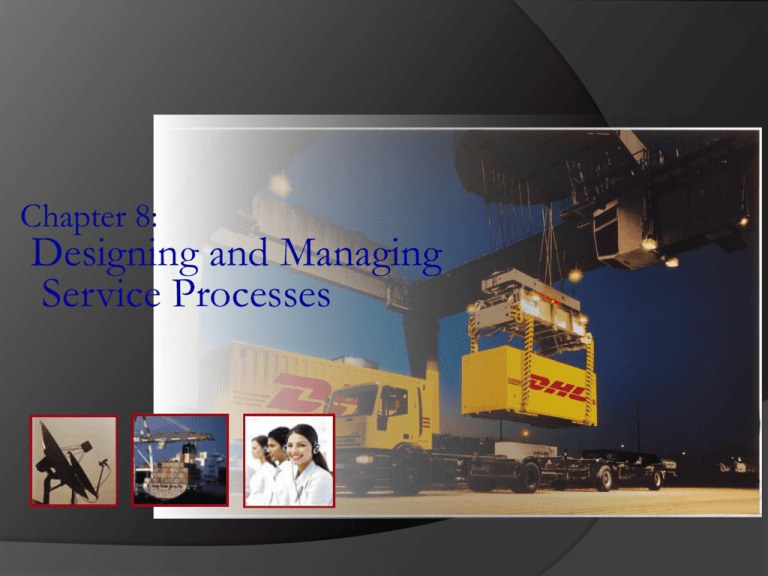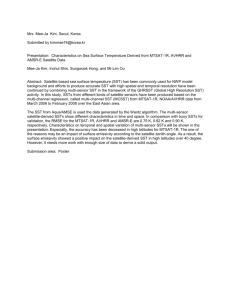File - ZTK Resources
advertisement

Chapter 8: Designing and Managing Service Processes Core and Supplementary Services at Luxury Hotel (Offering Much More than Cheap Motel!) Reservation Cashier Valet Parking Business Center Room Service Wake-up Call Internet Reception A Bed for the Night in an Elegant Private Room with a Bathroom Baggage Service Cocktail Bar Entertainment/ Restaurant Sports/ Exercise What Happens, When, in What Sequence? Time Dimension in Augmented Product (Fig 3.3) Reservation Parking Get car Check out Internet Check in Internet Use room USE GUESTROOM OVERNIGHT internet Porter Meal Pay TV Room service Time Frame of An Overnight Hotel Stay Before Visit (Real-time service use) Simple Flowchart for Delivery of a People-Processing Service (Fig 3.4) People Processing – Stay at Motel Park Car Check In Maid Makes up Room Spend Night in Room Breakfast Breakfast Prepared Check Out Simple Flowchart for Delivery of a Possession-Processing Service (Fig 3.4) Possession Processing – Repair a DVD Player Travel to Store Technician Examines Player, Diagnoses Problem Leave Store Technician Repairs Player Return, Pick up Player and Pay (Later) Play DVDs at Home Simple Flowchart for Delivery of Mental Stimulus-Processing Service (Fig 3.4) Mental Stimulus Processing – Weather Forecast Turn on TV, Select Channel Collect Weather Data View Presentation of Weather Forecast Meteorologists Input Data to Models and Creates Forecast from Output Confirm Plans for Picnic TV Weatherperson Prepares Local Forecast Weather Forecasting Is a Service Directed at Customers’ Minds (Fig 3.5) Simple Flowchart for Delivery of An Information-Processing Service (Fig 3.4) Information Processing – Health Insurance Learn about Options Select Plan, Complete Forms University and Insurance Company Agree on Terms of Coverage Pay Insurance Coverage Begins Customer Information Entered in Database Printed Policy Documents Arrive The Flower of Service (Fig 3.6) Information Payment Billing Consultation Core Exceptions Hospitality Safekeeping KEY: Facilitating elements Enhancing elements Order Taking The Flower of Service: Facilitating Services—Information Customers often require information about how to obtain and use a product or service. Examples of elements: Core Directions to service site Schedule/service hours Prices Conditions of sale Usage instructions The Flower of Service: Facilitating Services—Order Taking Customers need to know what is available and may want to secure commitment to delivery. The process should be fast and smooth. Examples of elements: Core Applications Order entry Reservations and check-in The Flower of Service: Facilitating Services—Billing “How much do I owe you?” Bills should be clear, Accurate, and intelligible. Examples of elements: Core Periodic statements of account activity Machine display of amount due The Flower of Service: Facilitating Services—Payment Customers may pay faster and more cheerfully if you make transactions simple and convenient for them. Core Examples of elements: Self service payment Direct to payee or intermediary Automatic deduction The Flower of Service: Enhancing Services— Consultation Value can be added to goods and services by offering advice and consultation tailored to each customer’s needs and situation. Examples of elements: Core Customized advice Personal counseling Management consulting The Flower of Service: Enhancing Services—Hospitality Customers who invest time and effort in visiting a business and using its services deserve to be treated as welcome guests— after all, marketing invited them! Core Examples of elements: Greeting Waiting facilities and amenities Food and beverages Toilets and washrooms Security The Flower of Service: Enhancing Services—Safekeeping Customers prefer not to worry about looking after the personal possessions that they bring with them to a service site. Core Examples of elements: Looking after possessions customers bring with them Caring for goods purchased (or rented) by customers The Flower of Service: Enhancing Services—Exceptions Customers appreciate some flexibility when they make special requests and expect responsiveness when things don’t go according to plan. Core Examples of elements: Special requests in advance Complaints or compliments Problem solving Restitution Developing a Blueprint Identify key activities in creating and delivering service Define “big picture” before “drilling down” to obtain a higher level of detail Distinguish between “front stage” and “backstage” Clarify interactions between customers and staff, and support by backstage activities and systems Identify potential fail points; take preventive measures; prepare contingency Develop standards for execution of each activity— times for task completion, maximum wait times, and scripts to guide interactions between employees and customers Key Components of a Service Blueprint 1. Define standards for front-stage activities 2. Specify physical evidence 3. Identify principal customer actions 4. Line of interaction (customers and front-stage personnel) 5. Front-stage actions by customer-contact personnel 6. Line of visibility (between front stage and backstage) 7. Backstage actions by customer contact personnel 8. Support processes involving other service personnel 9. Support processes involving IT - Identify fail points and risks of excessive waits - Set service standards and do failure-proofing Blueprinting the Restaurant Experience: Act 1 (Fig 8.1) Timeline Act 1 Check availability, insert booking Back Accept reservation Support Processes W Valet Parking W W Coat Room … Line of interaction Front - Physical Evidence Make Reservation - Stage Stage Service Standards and Scripts Maintain reservation system Greet customer, take car keys Take car to parking lot Maintain (or rent) facilities Greet, take coat, coat checks Contact person (visible actions) Hang coat with visible check numbers Contact person (invisible actions) Maintain facilities/ equipment Line of visibility Line of internal physical interaction Blueprinting the Restaurant Experience: A Three Act Performance Act 1: Prologue and Introductory Scenes Act 2: Delivery of Core Product Cocktails, seating, order food and wine, wine service Potential fail points: Menu information complete? Menu intelligible? Everything on the menu actually available? Mistakes in transmitting information a common cause of quality failure—e.g. bad handwriting; poor verbal communication Customers may not only evaluate quality of food and drink, but how promptly it is served, serving staff attitudes, or style of service Act 3: The Drama Concludes Remaining actions should move quickly and smoothly, with no surprises at the end Customer expectations: Accurate, intelligible and prompt bill, payment handled politely, guest are thanked for their patronage Setting Service Standards Service providers should design standards for each step sufficiently high to satisfy and even delight customers Standards may include time parameters, script for a technically correct performance, and prescriptions for appropriate style and demeanor Must be expressed in ways that permit objective measurement First impression is important as it affects customer’s evaluations of quality during later stages of service delivery Customer perceptions of service experiences tend to be cumulative For low-contact service, a single failure committed front stage is relatively more serious than in high-contact service Viewed more seriously because there are fewer subsequent opportunities to create a favorable impression Improving Reliability of Processes by Failure Proofing Errors include: Treatment errors—human failures during contact with customer ○ e.g., lack of courteous or professional behavior, failure to acknowledge, listen to, or react appropriately to the customer Tangible errors—failures in physical elements of service ○ e.g., noise pollution, improper standards for cleaning of facilities and uniforms, equipment breakdown Goal of fail-safe procedures is to prevent errors such as: Performing tasks incorrectly, in the wrong order, too slowly Doing work that wasn’t requested in the first place Redesigning Service Processes Why Redesign? “Institutions are like steel beams—they tend to rust. What was once smooth and shiny and nice tends to become rusty.” Mitchell T. Rabkin MD, formerly president of Boston’s Beth Israel Hospital Why Redesign? Revitalizes process that has become outdated Changes in external environment make existing practices obsolete and require redesign of underlying processes Creation of brand-new processes to stay relevant Rusting occurs internally Natural deterioration of internal processes; creeping bureaucracy; evolution of spurious, unofficial standards Symptoms: - Extensive information exchange Data redundancy High ratio of checking or control activities to value-adding activities, increased exception processing Customer complaints about inconvenient and unnecessary procedures Process Redesign: Approaches and Potential Benefits Eliminating non-value-adding steps Streamline front-end and back-end processes of services with goal of focusing on benefit-producing part of service encounter Eliminate non-value-adding steps Improve efficiency More customized service Differentiate company Delivering direct service Bring service to customers instead of bringing customers to provider Improve convenience for customers Productivity can be improved if companies can eliminate expensive retail locations Increase customer base Process Redesign: Approaches and Potential Benefits Shifting to self-service Increase in productivity and service quality Lower costs and perhaps prices Enhance technology reputation Greater convenience Bundling services Involves grouping multiple services into one offer, focusing on a well-defined customer group Often has a better fit to the needs of target segment Increase productivity Add value for customers through lower transaction costs Customize service Increase per capita service use Process Redesign: Approaches and Potential Benefits Redesigning physical aspects of service processes Focus on tangible elements of service process; include changes to facilities and equipment to improve service experience Increase convenience Enhance the satisfaction and productivity of front-line staff Cultivate interest in customers Differentiate company The Customer as Co-Producer Levels of Customer Participation Customer Participation Actions and resources supplied by customers during service production and/or delivery Includes mental, physical, and even emotional inputs Three Levels Low—Employees and systems do all the work - Often involves standardized service Medium—Customer inputs required to assist provider - Provide needed information and instructions - Make some personal effort; share physical possessions High—Customer works actively with provider to co-produce the service - Service cannot be created without customer’s active participation - Customer can jeopardize quality of service outcome (e.g., weight loss, marriage counseling) Self-Service Technologies (SSTs) Ultimate form of customer involvement Customers undertake specific activities using facilities or systems provided by service supplier Customer’s time and effort replace those of employees ○ e.g. Internet-based services, ATMs, self-service gasoline pumps Information-based services lend selves particularly well to SSTs Used in both supplementary services and delivery of core product ○ e.g. eBay—no human auctioneer needed between sellers and buyers Psychological Factors in Customer Co-Production Economic rationale of self-service Productivity gains and cost savings result when customers take over work previously performed by employees Lower prices, reflecting lower costs, induce customer to use SSTs SSTs present both advantages and disadvantages Benefits: Time and cost savings, flexibility, convenience of location, greater control over service delivery, and a higher perceived level of customization Disadvantages: Anxiety and stress experienced by customers who are uncomfortable with using them What Aspects of SSTs Please or Annoy Customers? People love SSTs when… SST machines are conveniently located and accessible 24/7—often as close as nearest computer! Obtaining detailed information and completing transactions can be done faster than through face-to-face or telephone contact People in awe of what technology can do for them when it works well People hate SSTs when… SSTs fail—system is down, PIN numbers not accepted, etc They mess up—forgetting passwords, failing to provide information as requested, simply hitting wrong buttons Key weakness of SSTs: Too few incorporate service recovery systems Customers still forced to make telephone calls or personal visits Blame service provider for not providing more user-friendly system HSBC: “The world’s local bank” Source: Courtesy HSBC Global site brought to customer’s local computer Putting SSTs to Test by Asking a Few Simple Questions Does the SST work reliably? Is the SST better than interpersonal alternatives? Firms must ensure that SSTs are dependable and user-friendly Customers will stick to conventional methods if SST doesn’t create benefits for them If it fails, what systems are in place to recover? Always provide systems, structures, and technologies that will enable prompt service recovery when things go wrong Dysfunctional Customer Behavior Disrupts Service Process Addressing the Challenge of Jaycustomers Jaycustomer: A customer who behaves in a thoughtless or abusive fashion, causing problems for the firm, its employees, and other customers Divergent views on jaycustomers “The customer is king and can do no wrong.” Marketplace is overpopulated with nasty people who cannot be trusted to behave in ways that selfrespecting services firms should expect and require Insight: There’s truth in both perspectives No organization wants an ongoing relationship with an abusive customer Six Types of Jaycustomers: The Thief The Rulebreaker The Belligerent The Deadbeat Family Feuders Vandals






